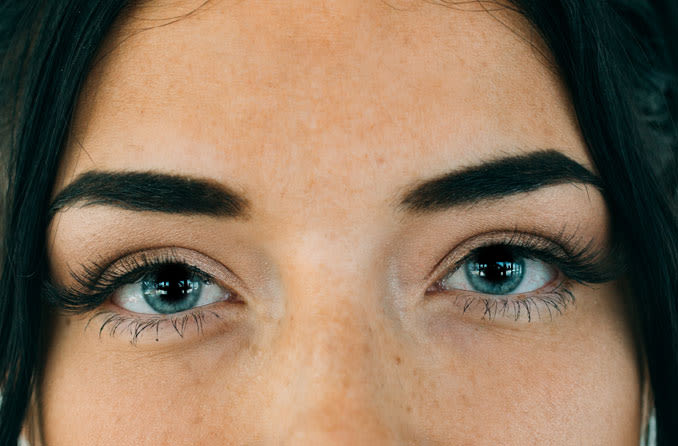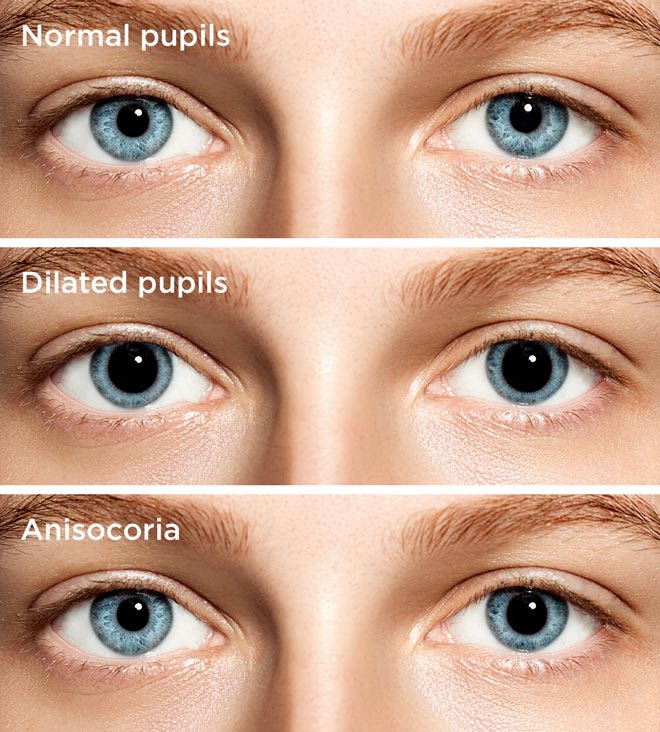What causes dilated pupils (dilated eyes)
The condition resolves and the pupil returns to normal size and function without treatment.
Why Do I Need to Get My Eyes Dilated?
Dilation is part of a thorough eye exam. You may think it’s a hassle. But it gives your doctor a good look inside your eye. It’s especially important if you’re having eye pain or vision problems, or if you’re more likely to get certain eye diseases.
Normally, your pupil gets smaller when light shines into it. In dilation, your doctor uses special eye drops to force the pupil to stay open. This allows them to see much more of the back of your eye, including the entire retina, the part of the retina called the macula, and the optic nerve.
During a dilated exam, your doctor can spot problems like a torn or detached retina or an eye tumor. They can also diagnose and monitor common eye diseases that can take away your sight:
- Diabetic retinopathy: Signs include blood vessels that leak, swell, or grow abnormally in the retina.
- Glaucoma: Your doctor looks for damage to the optic nerve.
- Age-related macular degeneration: Protein or pigment buildup and unusual growth of blood vessels are symptoms of a breakdown of the macula.
- Cataract: A clouding of your natural lens.
Almost all of these conditions are painless, so you may not even know you have one unless you see your doctor and have your eyes dilated.
How Long Does It Last?
Everyone’s eyes react differently to the dilation drops. It usually takes 15 to 30 minutes for your pupils to open completely. Most people are back to normal within about 4 to 6 hours. But for you, the effects could wear off more quickly, or they could last much longer.
Can I Drive?
Dilation doesn’t typically affect your distance vision, unless you are farsighted and don’t have glasses to correct your vision. But because your pupils can’t control the amount of light going into your eyes, the glare outside may bother you. For some people, that makes it unsafe to drive.
If you’ve never had your eyes dilated, get someone else to drive you home from your appointment. Once you’ve had it done, you’ll know whether dilation means you can’t drive after an exam.
Whether or not you get behind the wheel, it’s a good idea to bring sunglasses with you so you can shield your eyes after the exam.
Can I Go Back To Work?
Dilating drops make it hard for your eyes to focus on things close to you. You probably won’t be able to read, use the computer, or do other tasks that require near vision after your appointment, unless you wear bifocals or use reading glasses. If you work outside, the bright light may bother you. It may be easier to make an appointment later in the day so you don’t have to go back to work.
How Often Do I Need It?
The National Eye Institute recommends everyone over 60 have a dilated exam once a year. If you’re African-American, you’re at higher risk for glaucoma, so the yearly recommendation starts at age 40. If you have diabetes, you should also have a dilated exam once a year no matter how old you are.
Dilation is often a normal part of an eye exam for people who wear glasses or contacts. But if you’re young and your eyes are healthy, you may not need it every time. Your doctor also may be able to use other methods to check your retina without dilating your eyes, but they may not work as well. See what your doctor recommends.
Many eye diseases are more common as you get older. The American Academy of Ophthalmology says everyone should get a baseline exam with dilation when they’re 40. That way, your doctor can track any changes that could signal a problem.
Show Sources
National Eye Institute: “What is a comprehensive dilated eye exam?”
BrightFocus Foundation: “The Dilated Eye Exam: Why It’s So Important.”
The Cleveland Clinic: “To Save Your Vision, Doctors Look Deep Into Your Eyes.”
American Academy of Ophthalmology: “What to Expect When Your Eyes Are Dilated,” “Eye Exams 101.”
Eye: “Driving ability after pupillary dilatation.”
British Journal of Ophthalmology: “Pupil dilatation does affect some aspects of daytime driving performance.”
Mayo Clinic: “Eye dilation: Necessary with every eye exam?”
What causes dilated pupils (dilated eyes)?

Dilated pupils are pupils that are larger than normal. They are sometimes called dilated eyes.
The size of your pupils is controlled by tiny muscles in the colored part of your eye (iris) and the amount of light reaching your eyes.
In bright light, your pupils constrict (get smaller) to prevent too much light from entering your eyes. In dim lighting, your pupils dilate (get larger) to allow more light in.
Normal pupil size generally ranges from 2.0 to 4.0 millimeters (mm) in bright light, and 4.0 to 8.0 mm in the dark. To some degree, pupil size tends to get smaller with age.
In one study of 500 Americans ages 18 to 34 years, average pupil sizes in three different lighting conditions were found to be:

- 3.35 mm in direct light
- 3.86 mm in normal room lighting
- 6.41 mm in near-total darkness
If your pupils are significantly larger than these averages, you have dilated pupils.
A dilated pupil can sometimes still react to light — that is, get smaller in bright light or when a light is shined at the eye. But typically, dilated eyes don’t respond normally to light.
A large pupil that is completely unresponsive to light is called a “fixed” dilated pupil.
Dilated pupils aren’t the same as anisocoria, a common condition where both pupils react normally to light but differ in size by about a half-millimeter or more. Anisocoria is benign and affects about 20% of the population.
It’s normal for your pupils to dilate more the darker your surroundings. However, if your eyes are fully dilated even in a bright environment or if your eyes don’t seem to be dilating as they should, it’s time to get your eyes checked.
What causes dilated pupils?
The most common dilated pupil causes include:
Medications
The following prescription and non-prescription medicines can cause your pupils to dilate and affect their ability to react to light:
- Antihistamines
- Decongestants
- Tricyclic antidepressants
- Motion sickness medicines
- Anti-nausea medicines
- Anti-seizure drugs
- Medications for Parkinson’s disease
- Botox and other medications containing botulinum toxin
- Atropine (used for myopia control and other medical purposes)
Eye injury
A serious, penetrating eye injury can damage your iris and cause the pupil to become dilated and irregular in shape. Sometimes, this sort of injury can occur during an eye surgery, such as a complicated cataract surgery or a corneal transplant.
Brain injury or disease
A head injury, stroke or brain tumor can affect how your pupils react to light and cause dilated pupils. One or both eyes may be affected.
This is why you see physicians checking an athlete’s pupils with a penlight following head trauma sustained during sporting events, or when a patient arrives at a hospital emergency department with other possible stroke symptoms.
Recreational drug use
Research has shown that alcohol and marijuana — separately or in combination — can reduce your eyes’ ability to recover from exposure to a bright light source (such as oncoming headlights at night) and adapt to changing light conditions. This effect can last two hours or longer after drug ingestion.
However, the substances themselves do not cause your pupils to dilate.
A number of illegal drugs, however, do directly cause dilated pupils. This slows your eyes’ ability to react to light.
These drugs include:
- Amphetamines
- Cocaine
- LSD
- MDMA (Ecstasy)
SEE RELATED: Eye dilation FAQs
Benign episodic unilateral mydriasis
This is an unusual but harmless condition where a person experiences sporadic episodes of one pupil suddenly becoming dilated, often accompanied by blurry vision, headache and eye pain.
Young women who are prone to migraine appear to have the highest risk of benign episodic unilateral mydriasis. In one study, the median duration of the episodes was 12 hours (some lasted much longer) and the median frequency was two to three episodes per month.
The condition resolves and the pupil returns to normal size and function without treatment.
Adie’s pupil
Also called Adie’s tonic pupil or tonic pupil, this is a rare neurological disorder where one pupil is larger than normal and is slow to react to light. Sometimes, the pupil does not constrict at all.
This pupil abnormality may be accompanied by poor or absent tendon reflexes. When this occurs, the condition is called Adie’s syndrome.
Generally, the cause of Adie’s tonic pupil is unknown; but in some cases, it may be associated with trauma, surgery, poor blood circulation or infection. There’s no cure for Adie’s pupil or Adie’s syndrome.
Congenital aniridia
This is a rare condition where a person is born with a partially or completely absent iris, resulting in a very large “pupil.” Aniridia usually affects both eyes and is accompanied by other serious eye problems such as congenital cataracts, glaucoma, incomplete development of the retina and optic nerve, nystagmus, and decreased visual acuity.
Because there is little or no iris to regulate the amount of light entering the eye, people with aniridia are very sensitive to light.
Sexual attraction
It’s true — researchers have found that pupil dilation appears to correspond to adult men and women’s sexual interest in other adults. But there’s a catch.
One recent study showed that the pupils of male subjects dilated when they viewed images of women they found sexually attractive, whereas the pupils of female subjects typically dilated in response to images of attractive men and women alike. The study authors concluded the reason for this is unclear and that further research is warranted.
Treatment for dilated pupils
If you or someone else notices you have dilated pupils or one of your pupils looks larger than the other after head trauma, seek medical attention immediately.
The same is true if you experience sudden dizziness, headache, confusion, balance problems or other symptoms of a possible stroke.
If you notice dilated pupils after you’ve started taking one of the medications noted above, call your prescribing doctor for advice.
In cases other than those described above, call your eye doctor immediately for advice if you notice your pupils are dilated — especially if it comes on suddenly.
If you have dilated pupils or your pupils react slower than normal to changing light conditions, you will be more sensitive to sunlight. Eyeglasses that darken automatically in daylight or sunglasses with polarized lenses can make your eyes feel more comfortable outdoors.
Custom prosthetic contact lenses can also help reduce light sensitivity caused by dilated eyes. These lenses give the appearance of having equal pupils of normal size. Prosthetic contacts are especially beneficial for cases of aniridia and large, irregular pupils caused by trauma.
Notes and References
Clinical Methods: The History, Physical, and Laboratory Examinations. 3rd edition. Chapter 58: The Pupils. Butterworths. Boston. 1990.
The prevalence of simple anisocoria. American Journal of Ophthalmology. July 1987.
Adie syndrome. National Organization for Rare Diseases. Accessed May 2021.
Page published on Friday, February 1, 2019






